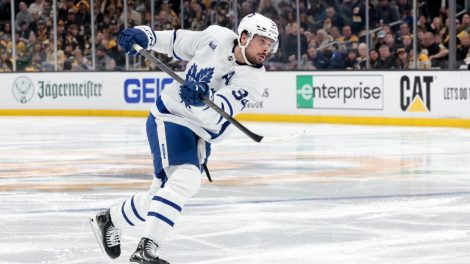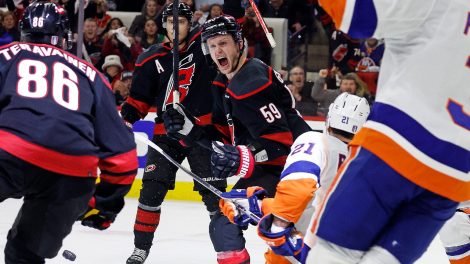Serge Ibaka is running laps up and down the hallway of his condo. Max Domi is doing hockey keep ups while balancing on an exercise ball. Ilya Kovalchuk is squatting with his wife on his shoulders. James Connor is hucking logs.
Professional athletes across every league are having to get creative to stay in shape in this period of social distancing. It’s certainly not ideal, but it’s the reality given the precautions needed to curb the spread of COVID-19, while also preparing for a potential return to play.
With team facilities shut down, in many cases athletes have been limited to workouts involving bodyweight exercises — though some have adjustable dumbbells — cardio and yoga, unless they have the luxury of a home gym.
The Toronto Raptors are among the many teams that have been forced to get creative to keep their players in shape.
The squad was caught right in the middle of the NBA’s brush with COVID-19, having played the Utah Jazz — and the league’s patient zero, Rudy Gobert — in their final game before basketball hit the pause button.
Forced into self-quarantine, Jon Lee, strength and conditioning coach for the Raptors, said one of his first moves was to get bikes delivered from the team’s training facility to his players.
Lee has also provided them with a bodyweight workout (similar to the one seen below) and he and team staff are in constant communication with players to give them structure.
It’s not perfect — Lee would prefer they have access to equipment that mimics the movement of running up and down a basketball court, such as a treadmill — but many players don’t have room. Keeping on-court skills sharp is also out of the question for most.
But Lee isn’t concerned about the Raptors getting out of shape.
“The guys that we have are elite athletes, and if they’re doing something at home — whether it’s the conditioning on a bike or if they have a treadmill — it is very difficult for guys to lose what they’ve gained over the years, especially with elite athletes, in a matter of months. Like it could take up to a year for you to like lose everything, and you still wouldn’t lose everything,” he said.
“So when these guys come back, I have no real worry about how quickly they can get back in.”
Part of Lee’s confidence comes from his faith in the Raptors’ veteran leadership group.
“We have real professional guys that I really don’t have to worry because they’re self-motivated, they’re not happy … with just one championship, they’re self-motivated enough to be like, ‘we’re getting another one.'”
Matt Nichol, superstar performance coach and founding partner of BioSteel Sports Supplements, shares Lee’s confidence — for now.
Nichol — who counts Tom Wilson and Jordan Binnington among his clients — said limitations placed on training aren’t really a huge issue, since at this point in the season the quality of many players’ off-ice workouts isn’t nearly as intense as it was earlier on or during the summer. Whatever they can do at home is enough to maintain a baseline level of fitness.
When the NHL initially paused its season, Nichol advised his athletes to take a few days to ensure their families were safe, rest and get back on a good sleep schedule.
Given the sudden absence of morning skates, practices, workouts, pre-game naps and games, Nichol also stressed the importance of creating a routine.
“Now it’s very easy (for) Saturday (to become) Sunday, Sunday becomes Monday and becomes Tuesday. When you don’t have to be somewhere at a certain time, it’s kind of just easy to get into vacation mode,” he said.
Once they settled in, Nichol encouraged his athletes to take it up a notch.
Whether that’s bodyweight exercises, interval training, working on hockey skills, or even activities such as watching video or meditating — the key is maxing out what they can do, and not worrying about what they can’t.
“Rather than being stressed out or worrying about the fact that you can’t skate and can’t get on the ice, OK, well (focus on) … ‘How many hours of stickhandling am I going to do today? How many shots did you take in the driveway?,'” said Nichol, comparing this type of training to the first phase of his summer programs.
“Is it optimal? Is it the best thing you can do — no it’s not. But it’s the best thing you can do given your current situation, so I guess like any other time in life, you just try to make the best of whatever situation you’re in.”
It’s not like some players have access to team facilities while others don’t — they’re all in the same boat.
“There’s obviously going to be rust, but I guess the good news is there’s going to be rust for everybody,” said Nichol.
There could even be an unforeseen benefit to a restricted training regimen — at least in the short-term.
Lee said the fact that his players are limited to light exercise and are avoiding pounding on their joints could help a team that has lost among the most man-games to injury, including to key players Kyle Lowry, Pascal Siakam, Marc Gasol and Norm Powell.
“When we did our 14-day quarantine, I thought to myself, ‘the silver lining in this is a lot of times when our guys come into the season, they’re in pretty good shape, or excellent shape, and as the season goes on, they’re getting to the point where — especially the guys that are playing a lot of minutes — are starting to almost be at a point of overtraining,” said Lee.
It’s a sentiment echoed by Eric Renaghan, head of strength and conditioning for the St. Louis Blues.
Renaghan said the NHL’s pause is a chance for his players — given their extensive schedule over the past two years, which included winning a Stanley Cup last June — to rest, heal and work on muscles (through exercises such as yoga and ELDOA) that get overused during the season, whether it’s on the ice or flying back and forth across the continent.
“There’s a lot of injuries that are hidden, a lot of things that are just nagging the athletes. And I think this is an opportunity for them to really take some time to regenerate those areas of need, focusing on mobility,” he said.
“I think that’s a huge component to performance and I think it gets overlooked because … you’re not putting a barbell on your back, you’re not doing things that are looking like they’re athletic.”
Nichol estimated that 10 per cent of NHL players are fully healthy at this point of the season.
“The majority of these guys are kind of just limping along from game to game, week to week at this stage of the season — it’s a grind,” he said.
“So I think having a couple of days to rest and reset … if you had a magic wand and you could make all this stuff go away next week, it might actually improve the quality of the hockey.”
But as league shutdowns stretch further along — with no clear end in sight — the risk for injury when athletes get back to action grows.
Lee said the Raptors will have to manage how much on-court pounding players take to prevent “quick injuries” from being unable to partake in basketball-related activities.
And Nichol warned they’ll need ample time to practice and get back into shape.
“The fear would be: do you rush the process as soon as you get some sort of medical, legal approval and throw guys out on the ice and they haven’t been training properly for at least a couple of weeks?” he said.
“That could definitely expose guys to greater risk — no question.”
With files from Sportsnet’s Ryan Dixon.
[relatedlinks]









